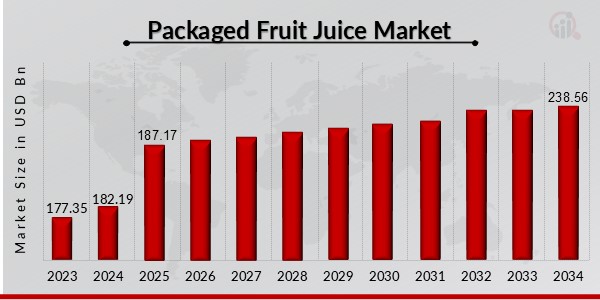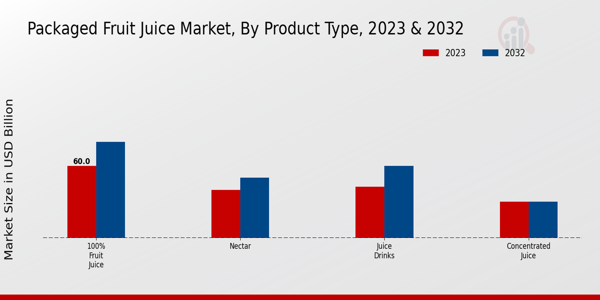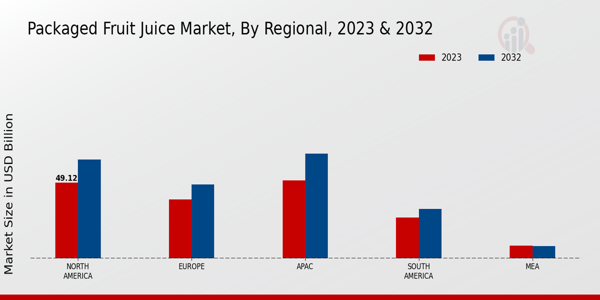Global Packaged Fruit Juice Market Overview
Packaged Fruit Juice Market Size was estimated at 182.19 (USD Billion) in 2024. The Packaged Fruit Juice Market Industry is expected to grow from 187.17 (USD Billion) in 2025 to 238.56 (USD Billion) by 2034. The Packaged Fruit Juice Market CAGR (growth rate) is expected to be around 2.7% during the forecast period (2025 - 2034).

Source: Primary Research, Secondary Research, MRFR Database and Analyst Review
Key Packaged Fruit Juice Market Trends Highlighted
The Packaged Fruit Juice Market is undoubtedly growing as a result of more and more customers opting for healthier beverages. Owing to the health craze, people have begun to prefer natural juices over sodas. This increasing trend is further fueled by growing knowledge about the health benefits of fruit juices which include vitamins, antioxidants, etc. On the other hand, the growing trend of fast-paced hectic schedules has made it favorable for consumers who prefer ready-to-drink packaged juices as their go-to for refreshments. Moreover, the changes in packaging and introduction of new flavors act as major factors in this market. Further, there are opportunities in the fruit juice industry mainly in the area of product diversification.
Companies are turning towards organic and cold-pressed juices which are growing in popularity among health-centered people. There is also a significant increase in the trend toward integrating superfood and functional ingredients into juice. Online channels and health-related retail will also strengthen market growth. Further, brands with sustainable vision and intention are also bringing the green audience segment into their fold, reaching those modern consumers that are eco-friendly. More recent years have seen consumers shifting to the premium products, especially in the fruit juice category where the clientele is ready to spend extra for better quality and flavors.
Packaged Fruit Juice Market The interest in tropical and exotic fruit flavors is also on the rise, reflecting a consumer desire for novel taste experiences. Additionally, clean-label products with minimal additives are gaining popularity as transparency in ingredients becomes more important to consumers. These trends signify a shift toward more thoughtful consumption patterns, where quality and health benefits take precedence over mere convenience. Overall, the packaged fruit juice market is navigating a dynamic landscape shaped by evolving consumer preferences and a collective push towards healthier, sustainable options.
Packaged Fruit Juice Market Drivers
Increasing Health Consciousness Among Consumers
Health consciousness has become a significant driver for the Packaged Fruit Juice Market Industry in recent years. Consumers are increasingly looking for healthier beverage alternatives that are low in sugar and rich in nutritional content. The trend towards organic and natural products has prompted manufacturers to innovate and offer juice options that are fortified with vitamins and minerals. As people become more aware of the importance of maintaining good health and nutrition, they are turning to packaged fruit juices as a convenient way to incorporate essential vitamins and minerals into their diet.This shift in consumer preferences is evident as more individuals seek products that cater to their health-related goals, including immune support, detoxification, and overall wellness. Additionally, the rise of social media and health influencers has pushed brands to highlight the health benefits of their products. This driver not only reflects changing consumer behaviors but also indicates a long-term trend towards healthier living that is expected to continue to influence the Packaged Fruit Juice Market positively.
Expansion of Distribution Channels
The expansion of distribution channels is a crucial driver for the Packaged Fruit Juice Market Industry. As retailers and companies invest in improving their supply chain infrastructure, packaged fruit juices are becoming more accessible to consumers. The shift towards e-commerce has further increased availability, with many online platforms now offering a range of fruit juices that were previously only available in physical stores. Direct-to-consumer models have also gained traction, allowing brands to reach their customers more efficiently.This diversification in distribution not only caters to varying consumer preferences but also encourages impulse purchases, significantly boosting sales for the packaged fruit juice segment.
Innovation and Product Diversification
Innovation in flavors and formulations continues to be a strong driver for the Packaged Fruit Juice Market Industry. Brands are constantly introducing new flavors, blends, and health-oriented products, such as cold-pressed juices, smoothies, and functional drinks. This trend is buoyed by consumer demand for variety and unique taste experiences. Additionally, the introduction of limited-edition flavors and seasonal offerings helps in creating excitement around the product lineup, enticing consumers to try new options.This ongoing innovation not only aids brands in maintaining consumer interest but also opens up new market segments and opportunities for growth.
Packaged Fruit Juice Market Segment Insights
Packaged Fruit Juice Market Product Type Insights
The Packaged Fruit Juice Market is a dynamic and expanding sector, projected to experience considerable growth over the next few years. As of 2023, the market comprises various product types, with one of the dominant categories being 100% Fruit Juice, which holds a valuation of 60.0 USD Billion. This segment's appeal arises from its perception as a healthier option, offering consumers an unadulterated fruit experience without added sugars or artificial ingredients. The significant growth for this category is expected to reach 80.0 USD Billion by 2032, marking it as a leading player in the industry.Additionally, Nectar, valued at 40.0 USD Billion in 2023, is recognized for its flavorful blends and slightly higher sugar content compared to 100% Fruit Juice, making it popular among consumers seeking a sweet and refreshing beverage. By 2032, the Nectar segment is projected to grow to 50.0 USD Billion, reflecting its sustained consumer interest. Juice Drinks, which are priced more affordably, accounted for 42.63 USD Billion in 2023 and have the potential to reach 60.0 USD Billion by 2032. The segment thrives on convenience and varied flavors, catering to a broader audience, especially families and young consumers.Concentrated Juice, while remaining steady at 30.0 USD Billion for both 2023 and 2032, serves a specific niche among consumers looking for concentrated options for beverages and culinary uses. This market segmentation highlights how the diverse categories within the Packaged Fruit Juice Market revenue capture various consumer preferences, promoting healthy living while meeting varying taste profiles. The trends driving growth in these segments include increased health consciousness, the pursuit of natural ingredients, and a rising demand for convenient beverage solutions.However, challenges in sustainability practices, price fluctuations in raw materials, and competition from alternative beverages may pose hurdles to growth. Overall, the clear segmentation within the Packaged Fruit Juice Market data illustrates a robust landscape rich with opportunities for expansion, innovation, and increased market penetration.

Source: Primary Research, Secondary Research, MRFR Database and Analyst Review
Packaged Fruit Juice Market Flavor Insights
In 2023, the Packaged Fruit Juice Market was valued at approximately 172.63 USD Billion, showcasing a diverse range of flavors that significantly contribute to market growth. Within this segment, various flavors such as Orange, Apple, Grape, and Mixed Fruit play pivotal roles. Orange juice remains a perennial favorite, appreciated for its refreshing taste and health benefits, making it a key player in the market. Apple juice, known for its versatility and wide consumer appeal, captures significant attention, while Grape juice, with its rich flavor and potential health advantages, also finds a strong foothold.Mixed Fruit juice, appealing to those seeking variety, is becoming increasingly popular as consumers lean towards blends that offer multiple nutrients and flavors. The Packaged Fruit Juice Market data reflects trends toward health-conscious choices, with consumers preferring natural ingredients and less added sugar, which presents both challenges and opportunities for producers. The segmentation of flavors not only enhances the market’s appeal but also showcases the evolving preferences of consumers leaning towards nutritious and flavorful juice options as part of their daily diet.
Packaged Fruit Juice Market Packaging Type Insights
In 2023, the Packaged Fruit Juice Market is valued at 172.63 USD Billion, showcasing a diverse Packaging Type landscape, which is crucial for market growth and consumer preferences. The primary packaging formats include Glass Bottles, Plastic Bottles, Tetra Packs, and Cans, each holding significant importance. Glass Bottles are often preferred for premium juices due to their non-reactive nature, which preserves flavor and quality. Plastic Bottles dominate the market due to their lightweight convenience and lower production costs, making them popular among consumers.Tetra Packs have emerged as a significant option due to their capability of preserving juice for extended periods without the need for refrigeration, thus enhancing supply chain efficiency. Cans, while less prevalent, are gaining traction attributed to their recyclability and compactness, aligning with the growing trend of sustainability. Each of these packaging types is driven by changing consumer preferences, environmental concerns, and the demand for convenience, reflecting a complex segmentation within the Packaged Fruit Juice Market industry.The balance and trends among these packaging choices underscore their pivotal role in the overall market dynamics while propelling the Packaged Fruit Juice Market revenue and shaping its future trajectory.
Packaged Fruit Juice Market Distribution Channel Insights
In 2023, the Packaged Fruit Juice Market was valued at approximately 172.63 USD Billion, showcasing a diverse Distribution Channel landscape. This market consists of various channels, including Supermarkets/Hypermarkets, Convenience Stores, Online Retail, and Food Service. Supermarkets and hypermarkets play a pivotal role, offering a wide array of brands and flavors, thus catering to consumer preferences effectively. Convenience Stores, with their focus on accessibility and quick shopping experiences, have gained traction among busy consumers.Meanwhile, Online Retail has seen substantial growth due to the increasing trend of e-commerce and changing consumer behaviors, offering convenience and home delivery options. The Food Service sector also contributes significantly, primarily driven by demand in restaurants, cafes, and other food establishments where packaged fruit juices are prominently featured on menus. These channels not only reflect the evolving purchasing trends among consumers but also highlight the dynamic nature of the Packaged Fruit Juice Market segmentation, driving overall market growth through enhanced accessibility and varied product offerings.Factors such as lifestyle changes, health awareness, and a preference for ready-to-drink products continue to shape the distribution dynamics, presenting multiple opportunities within this industry.
Packaged Fruit Juice Market Regional Insights
The Packaged Fruit Juice Market is experiencing robust growth, with regional segmentation playing a vital role in shaping its landscape. In 2023, North America holds a significant position with a valuation of 49.12 USD Billion, expected to rise to 64.0 USD Billion by 2032, affirming its majority holding in the market. Europe follows closely, valued at 38.25 USD Billion in 2023 and projected to reach 48.0 USD Billion, indicating its strong foothold due to consumer preferences for healthy beverages. The APAC region shows substantial potential as well, valued at 50.58 USD Billion in 2023, driven by a growing health-conscious population and increasing disposable incomes, with expectations to expand to 68.0 USD Billion.In contrast, South America stands at 26.45 USD Billion and is set to increase to 32.0 USD Billion, highlighting its emerging significance as preferences shift towards natural and organic juice options. The MEA market, valued at 8.23 USD Billion, while currently smaller, shows promise as health trends gain traction. Overall, the regional distribution reveals diverse opportunities and growth drivers across the Packaged Fruit Juice Market, shaping its competitive dynamics while presenting unique challenges tailored to local consumer preferences.

Source: Primary Research, Secondary Research, MRFR Database and Analyst Review
Packaged Fruit Juice Market Key Players and Competitive Insights
The Packaged Fruit Juice Market is characterized by a rapidly evolving landscape driven by changing consumer preferences, increasing health consciousness, and a growing demand for convenient and nutritious beverage options. This market showcases a variety of players, including established brands and new entrants. Competitive dynamics are influenced by factors such as innovation in flavors, packaging, product quality, and pricing strategies. Companies are focusing on sustainability practices and transparency in sourcing to cater to an increasingly informed consumer base. Additionally, the rise of e-commerce platforms is reshaping distribution strategies and expanding market reach for various brands. In this environment, companies must continuously adapt to trends, including the growing popularity of organic and cold-pressed juices, as they strive to capture consumer loyalty in a crowded space.Ocean Spray stands out in the Packaged Fruit Juice Market with its extensive portfolio of cranberry-based products, leveraging its cooperative model that supports local farmers. This company has a strong brand heritage tied to high-quality fruit juice, particularly cranberry juice. Ocean Spray's commitment to innovation is evident in its product offerings, which have expanded to include blends and functional beverages that cater to health-conscious consumers. Its effective marketing strategies emphasize the health benefits of cranberry juices, which resonate with consumers looking for antioxidants and nutrient-rich options. Furthermore, Ocean Spray's strategic partnerships and collaborations enhance its distribution network, enabling it to maintain a significant presence in various regional markets. The brand's dedication to sustainability and responsible sourcing further strengthens its reputation and appeal among modern consumers.Unilever plays a pivotal role in the Packaged Fruit Juice Market, leveraging its extensive distribution channels and global reach. The company’s diversified portfolio includes a range of fruit juice products positioned to capture both premium and value-seeking segments. Unilever emphasizes research and development, ensuring its products align with consumer trends regarding health and wellness. The company invests heavily in marketing campaigns that highlight the natural ingredients and sustainability aspects of its juices, fostering a positive brand image. Additionally, Unilever’s commitment to environmental responsibility and its ambition to make sustainable living commonplace resonate well with the growing segment of eco-conscious consumers. This strategic focus allows Unilever to maintain a competitive edge in the fruit juice market, consolidating its position as a leader in delivering quality, flavorful, and nutritious juice options to consumers worldwide.
Key Companies in the Packaged Fruit Juice Market Include:
- Ocean Spray
- Unilever
- Ribena
- Kraft Heinz
- Florida's Natural Growers
- Tropicana Products
- Welch's
- Bolthouse Farms
- Happy Tree
- Dole Food Company
- CocaCola
- Dr Pepper Snapple Group
- Nestlé
- Mott's
- PepsiCo
Packaged Fruit Juice Market Industry Developments
The Packaged Fruit Juice Market is currently experiencing significant developments, with companies like Tropicana Products and Coca-Cola focusing on expanding their product ranges and introducing innovative flavors to meet changing consumer preferences. Unilever has recently unveiled a new line of fruit juices that emphasize organic and sustainable sourcing, aligning with the growing health consciousness among consumers. In terms of mergers and acquisitions, Kraft Heinz has pursued strategic partnerships to enhance its portfolio in the juice sector, while Ocean Spray has expanded its distribution channels to strengthen its market presence. The emergence of health-oriented brands like Happy Tree and Bolthouse Farms signifies a trend toward premium, natural juices, attracting a niche market segment. Meanwhile, the recent growth in market valuations for well-established companies such as PepsiCo highlights the increasing demand for convenient, ready-to-drink beverage options. The shift towards e-commerce is also influencing purchasing patterns, with many consumers opting for online orders from brands like Welch's and Mott's, reflecting a significant change in retail dynamics within the juice market. These trends collectively underscore a dynamic landscape shaped by consumer preferences for health, sustainability, and convenience in the Packaged Fruit Juice Market.
Packaged Fruit Juice Market Segmentation Insights
Packaged Fruit Juice Market Product Type Outlook
- 100% Fruit Juice
- Nectar
- Juice Drinks
- Concentrated Juice
Packaged Fruit Juice Market Flavor Outlook
- Orange
- Apple
- Grape
- Mixed Fruit
Packaged Fruit Juice Market Packaging Type Outlook
- Glass Bottles
- Plastic Bottles
- Tetra Packs
- Cans
Packaged Fruit Juice Market Distribution Channel Outlook
- Supermarkets/Hypermarkets
- Convenience Stores
- Online Retail
- Food Service
Packaged Fruit Juice Market Regional Outlook
- North America
- Europe
- South America
- Asia Pacific
- Middle East and Africa
| Report Attribute/Metric |
Details |
| Market Size 2024 |
182.19 (USD Billion) |
| Market Size 2025 |
187.17 (USD Billion) |
| Market Size 2034 |
238.56 (USD Billion) |
| Compound Annual Growth Rate (CAGR) |
2.7% (2025 - 2034) |
| Report Coverage |
Revenue Forecast, Competitive Landscape, Growth Factors, and Trends |
| Base Year |
2024 |
| Market Forecast Period |
2025 - 2034 |
| Historical Data |
2019 - 2023 |
| Market Forecast Units |
USD Billion |
| Key Companies Profiled |
Ocean Spray, Unilever, Ribena, Kraft Heinz, Florida's Natural Growers, Tropicana Products, Welch's, Bolthouse Farms, Happy Tree, Dole Food Company, CocaCola, Dr Pepper Snapple Group, Nestlé, Mott's, PepsiCo |
| Segments Covered |
Product Type, Flavor, Packaging Type, Distribution Channel, Regional |
| Key Market Opportunities |
Health-focused product innovations, Sustainable packaging solutions, Expansion in emerging markets, Rise of organic juice options, Enhanced online distribution channels |
| Key Market Dynamics |
Health consciousness among consumers, Rising demand for convenience products, Growth of e-commerce platforms, Increasing flavor innovations, Expansion in emerging markets |
| Countries Covered |
North America, Europe, APAC, South America, MEA |
Frequently Asked Questions (FAQ) :
The Packaged Fruit Juice Market is expected to be valued at 238.56 USD Billion by 2034.
The expected CAGR for the Packaged Fruit Juice Market from 2025 to 2034 is 2.7%.
North America is projected to have the largest share in the Packaged Fruit Juice Market by reaching 64.0 USD Billion by 2034.
The 100% Fruit Juice segment is expected to be valued at 80.0 USD Billion by 2034.
The Juice Drinks segment is projected to be valued at 60.0 USD Billion in 2034.
Key players include Ocean Spray, Unilever, Kraft Heinz, CocaCola, and Nestlé, among others.
The Packaged Fruit Juice Market is expected to be valued at 172.63 USD Billion in 2024.
The Nectar segment is expected to grow to 50.0 USD Billion by 2034.
The APAC region is expected to reach a market size of 68.0 USD Billion by 2034.
The Concentrated Juice segment is projected to maintain a value of 30.0 USD Billion by 2034.

















